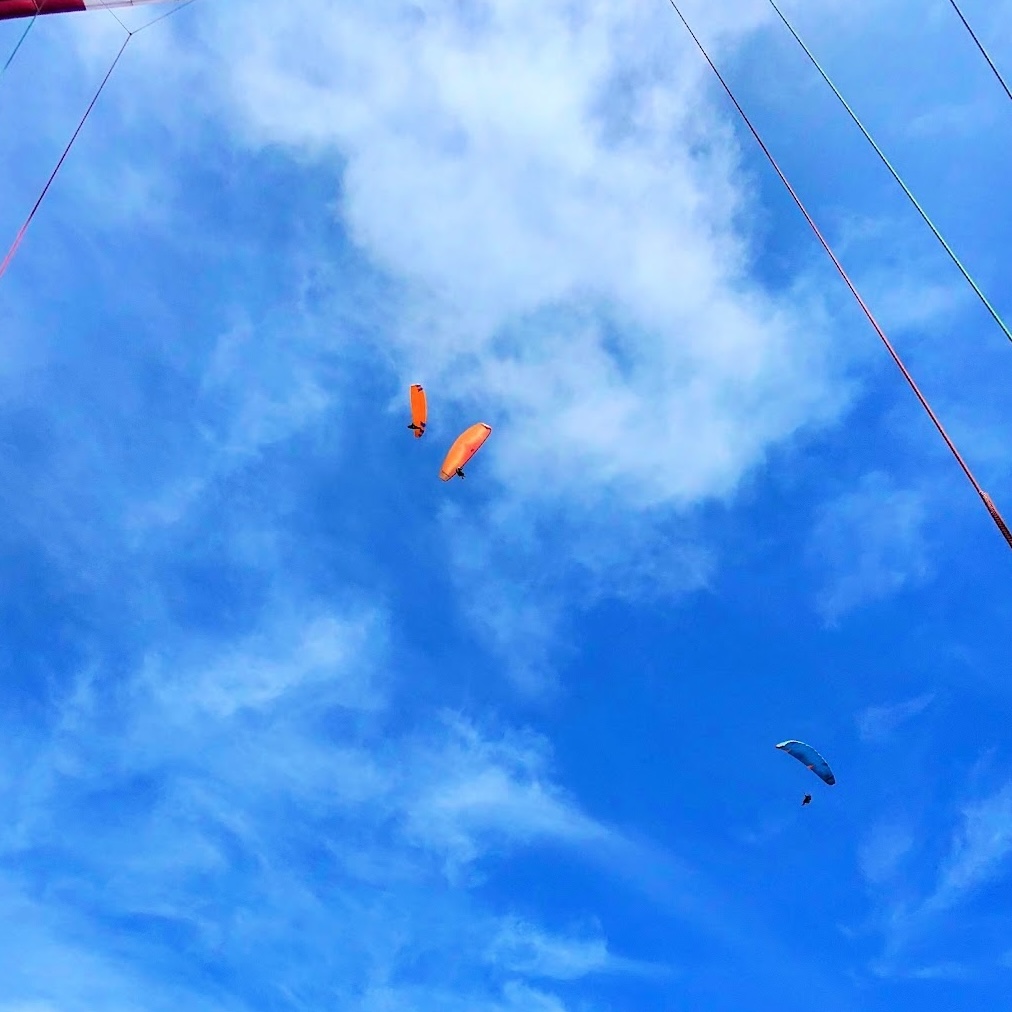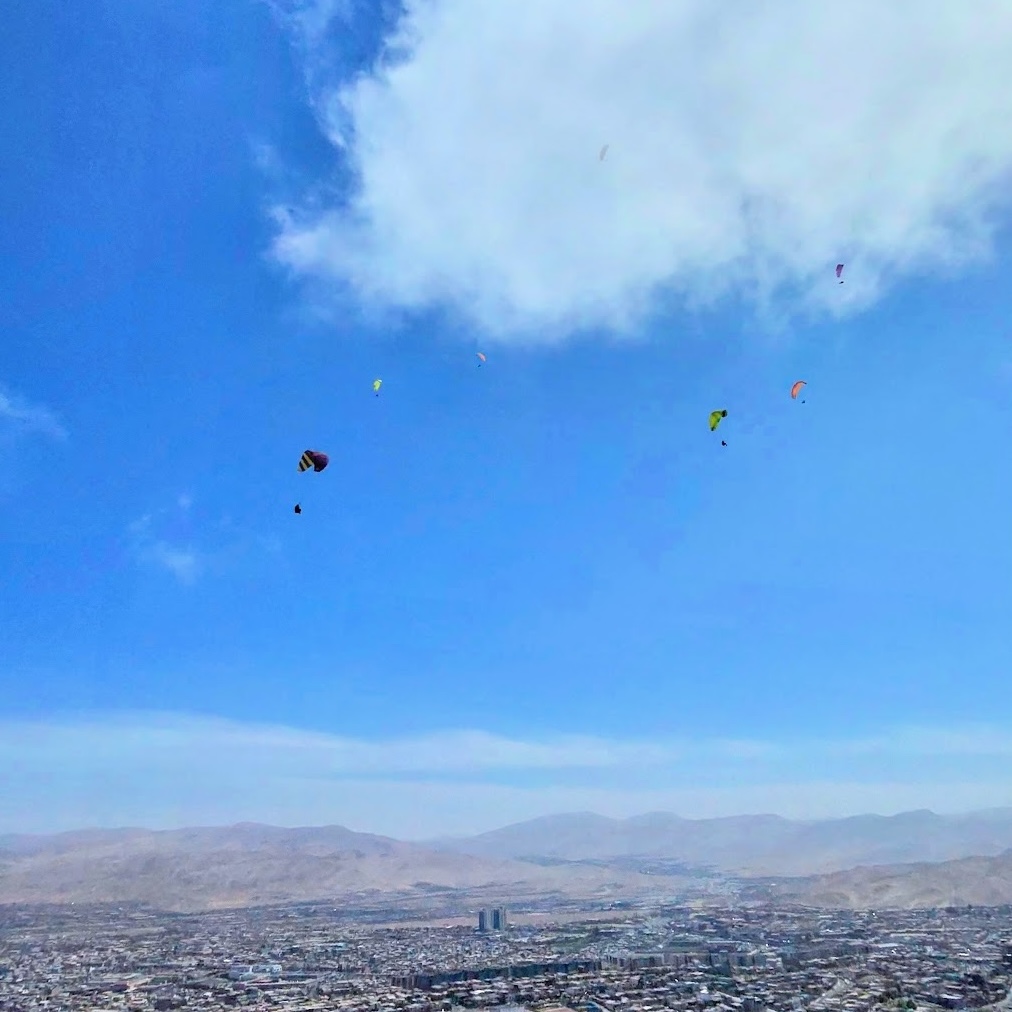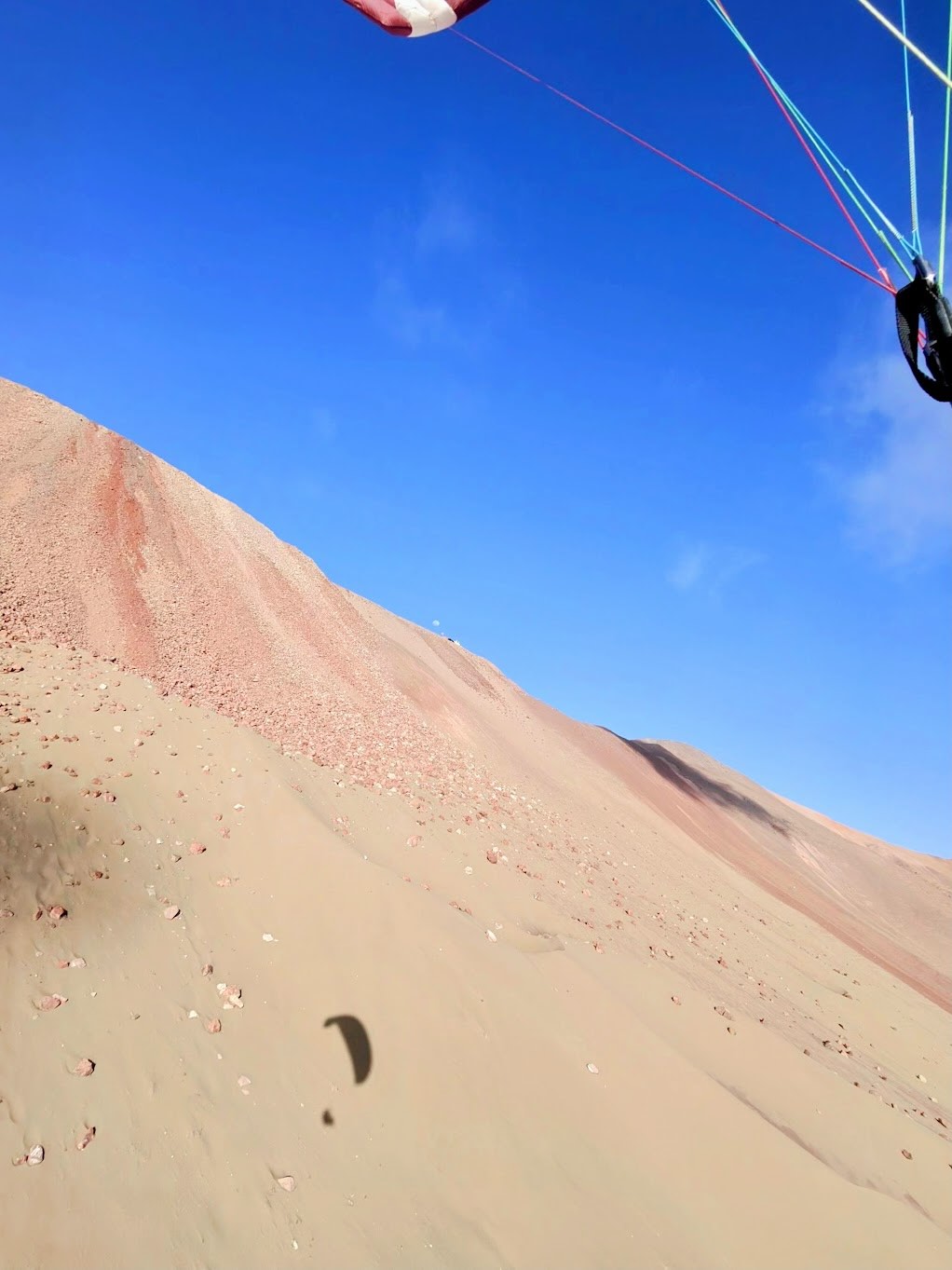In early November I went to Iquique, Chile with our paragliding community to fly, under the lead of our instructor. It’s my first time flying outside of the US.
Many regard Iquique as the best place to paraglide in the world because the weather and the terrain make the lift very strong and consistent, and it’s true. Even on days where the wind seems weaker, we were still able to stay up.
There are 2 main flying sites in Iquique, Alto Hospicio, a city on the plateau above Iquique city proper, and Palo Buque, a series of sandy slopes connecting to the top of the plateau south of Iquique city.
Paragliding from Alto Hospicio
Alto Hospicio is the city on the plateau that you can see from Iquique down there. They launch site is a very big and wide slope, and a woman would come and put some turf on it for paragliders to launch every day, and charge you for it.
The part where we launched is fine, but the other parts of the slope is pretty messy and dirty with lots of garbages like cans and bottles needles and stuff, kind of like an unmaintained beach. It is said that they used to bury dead dogs there as well.
The flight pattern is rather simple, thermalling/ridge soaring along the ridge, and head to the beach to land when you’re low or just have enough. Our instructor said that it’s all thermals not ridge lift, but also ridge lift created by thermals. From my experience it is thermals + ridge lifts. Ridge lift is pretty consistent if you stay close to the ridge, and along the ridge you can find thermals from time to time shooting you to the clouds.
There are a couple of sections along the ridge, from south to north they’re the house thermal, the launch, the prison, the mine, and the north cross.
The house thermal is a bowl area that produces a lot of consistent thermals. We typically start our flight in this area to gain altitude and play a bit. To the north is the launch, and it’s a straight ridge line until the prison, which is some kind of military complex tho it looks pretty empty from the sky. Between the prison and the mine is a bowl, and due to the direction of the wind you should not go through but around the bowl to avoid rotors.

Once you made across you’d arrive at the mine, which is literally a mine. You can see some trucks and bulldozers poking around here from the sky. It’s south/west facing so there’s plenty of lift along the slope and sometimes very nice thermals on top of the plateau. If you manage to thermal to a nice altitude in the mine, you can head north toward the north cross.

Between the mine and the north cross is a long west facing slope with weak lift. You generally have to stay very close to the slope to get enough lift to barely stay up. But if you make it to the north cross, which is actually a series of cross from the top of the mountain to the bottom, you can sometimes fine really strong thermal over here, taking you to the clouds.

Away from the ridge there’s a dragon, which is a long and tall (tho it looks pretty short vertically from the plateau) sand dune between the city and the plateau, which looks like of like the back of a dragon. There are some weak lifts along the slope of the sand dune, and occasionally strong thermals.
When you want to land, there are 2 main beaches serving as landing zones, the “hotel beach” (Playa Brava) and the Cavancha beach. We call the former “hotel beach” because our hotel is right next to it. To make it to the beaches from the ridge, you first need to cross the whole city, which is an absolutely amazing experience. It’s probably my favorite flight section so far in paragliding, looking at the stadium and football fields and roads and cars and condos right beneath you under a big blue sky and beside a big blue ocean. Surreal.

Personally I prefer to land on the Cavancha beach even though it’s farther from our hotel because of how beautiful and lively it is. The beach is long and white and clean and beautiful, and it’s always full of ppl playing and chilling, so you have to survey the beach carefully to find good landing spots with enough buffer. One time when I landed there was a group of children/teen surrounding me before and after I landed acting so excited, making me feel like a celebrity or something. Another time 2 latinas in bikinis walked to me and asked about “dinero” while gesturing my glider doing 360s and flying down, but I wasn’t sure if they’re asking about how much was it to fly tandem with me or how much did the glider cost.

And tho it’s a 10-20min. walk from the Cavancha beach back to the hotel, it is always an amazing walk because of how of the vibe and how well organized the beach is with beautiful pedestrian and biking paths and sand football fields and stuff, So fun and so chill.

On the contrary, the hotel beach is just gray and sad with very crazy waves and nobody’s there.
Paragliding in Palo Buque
Palo Buque is a paragliding site south of Iquique city, 30min from our hotel. It’s basically just big sandy slope below the plateau.
I really like this site because of how open the terrain is. I’ver never seen this kind of massive sandy slope/bowl/ridge that stretches infinitely before.
We usually arrived there before 5pm. Of the 6 afternoons we were there, 5 of them offered really strong winds.
Before this trip I could only dream about doing kiting in cobra while walking uphill, but I learned it on the first day in Palo Buque. The strong winds made it really easy, just hold your wing up, pull break to make the wingtip down almost touching the ground, and let it drag you.

The whole beginner-safe area consisted of 3 ridges, the main ridge, Dune Dominica (I don’t really know how to spell it and can’t find any info online), and the black mountain. Each area is a essentially big bowl.
To launch, you keep kiting up the slope, and when you feel the wind is strong enough for your altitude, turn around and run down the slope to get lifted up. Once you’re in the air, just zig zagged up along the ridge.
Once you’re high enough in the main ridge, you can make you way to Dune Dominica, which is another sandy bowl. And if you’re high in Dune Dominica, you can fly to the back of the black mountain.
Before reaching the black mountain is a north facing slope, while the prevailing wind is south-west, meaning that side of the slope is on the lee side and you do not want to be there. Therefor, you can’t just follow the ridge to the black mountain but fly through the open air to get around it.

Once you’re on the south facing side of the black mountain, you’ll experienced a ton of lift, and after a couple of zig zags, you’ll be brought to above the ridge, allowing you to see the nothingness on the plateau.

On a cloudy day, you can easily get into the clouds if you’re not careful. You do not want to be fully in the clouds because in a white out you won’t be able to know if you’re about to have a collapse with another glider or if the wind pushed you to the lee side of the ridge. This actually almost happened to me one time, and after that I finally internalized the danger of the clouds.

On a strong and cloudy day, you can easily still be in the air when it’s already dark. It was actually kind of scary when they just wouldn’t let you down even when you were already far away from the ridge. And when you’re trying to land, sometimes it’s so strong that you’ll get literally hanged a just few feet above the ground, very interesting.
Sometimes the south wind is so strong that your ground speed is literally zero, so you’ll just be like sitting on a chair in the air not moving for an hour.
On the last day my instructor told me how to fly backward. It’s actually very easy to just twist the risers to do a 180-degree turn, but the hard part is to stay in that backward position. After a lot of practices, I managed to use my forearms to apply pressure on the risers while backward to maintain my position, and ever successfully did a 360 turn, because using my forearm to hold the risers freed up my hands, allowing me to still pull the brakes.
I also got the practice some sidehill landing on the slopes. The first few times I pulled too much brake after landing causing the wings to drop, but after some practices I managed to touch and go easily, tho I still can’t do spot landing sidehill.
It’s a great maybe the best place to practice sidehill landing because it’s sands. Many people are literally foot dragging while flying there. If you land hard sidehill, you’re just deep in the sands, no one cares. One of our guys crashed on the slope downwind in a strong day, but he didn’t even get a scratch.
It’s truly a magical site, especially in the golden hours. When I came back to Dune Dominica from the black mountain, I was usually super high and away from the ridge, but under the golden hours sunlight on the sandy slopes if essentially the same color, I always felt like I was pretty close from the ridge, so when I saw these tiny gliders sticking on the slope it felt so unreal for how micro they were.

Holiday Inn Express
It’s a pretty nice hotel in a great location. Cross the road and you’re at the beach, walk 3 min and you’re at a time market, a small grocery store, 5 min and you’re at Jumbo, a Walmart supercenter sized supermarket with a good cafeteria and an open food court.
The breakfast is nothing phenomenal but fine for a 3-star hotel.
I recently stayed in a Best Western Plus in the US which is absolutely miserable, sad room sad public spaces sad breakfast, so this Holiday Inn Express felt so premium in comparison, but it’s really just a regular hotel outside of Murica.
Iquique
I didn’t like this city at first. Many of the buildings at the south of the town looks very ghetto-ish and the smell of the sea is pretty overwhelming. However, over the week, it started to grow on me, especially after I landed on the beautiful Cavancha beach for the first time.
I was shocked by the local price. The gas is the more expensive than Bay Area, and I feel like the cost of groceries and eating out is higher than Taiwan, tho livingcost.org says Taipei is 50% more expensive.
I had ceviche 3 times here. I still don’t love it but it’s very interesting.
Overview
I got 24.5hr of flying over 6.5 days or 13 flying sessions just from this trip alone, that’s already over the P3 flying hours requirement. And the 24.5hr isn’t just some hand free effortless flying in Mussel Rock but lots of kiting, thermalling and active ridge soaring.
I’d definitely recommend P2s to come here to fly. You can really grow a lot as a P2 if you stay here for a week. I flew in as a noob and flew out as a (noob) pilot.